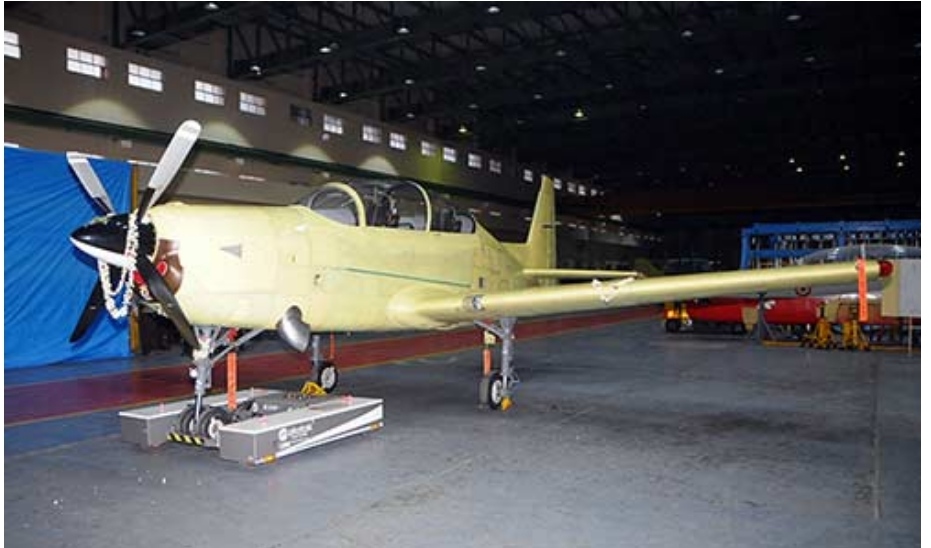HTT40 To Soon Join The UAF Fleet As Basic Trainer

The IAF on Feb. 4 issued a Request for Proposal (RFP) for 70 HTT40 ( Hindustan Turboprop Trainer) with additional clause of 36 more, from the Hindustan Aeronautics Limited (HAL).
The RFP has come within six years from the first flight of the trainer aircraft which is shortest time-line in aircraft industry. The fixed wing aircraft will have more than 60 per cent indigenous content.
The RFP documents were handed over to Madhavan by Air Marshal Sandeep Singh and V. L. Kantha Rao, director general (Acquisition) at the Ministry of
India’s defence acquisition council or DAC, chaired by Defence Minister Rajnath Singh had on August 11, 2020, approved the purchase of 106 HTT-40 trainers for the IAF at a cost of INR76 billion.
The production of the basic trainer aircraft will take place at HAL’s two manufacturing units at Bengaluru and Nashik.
The certification will be given against the Program Compliance and Quality Review (PCQR). claimed.
The new HTT40 trainer was developed to replace the HAL-designed HPT-32 Deepak. It is powered by a Honeywell Garett TPE331-12B single-shaft turboprop engine, and will be fitted with Mk.16 ejection seats. HPT-32 was grounded in 2009 following a series of accidents.
The HTT-40 will have weapons training and other features that will help enable the pilots to graduate to an advanced jet trainer (AJT) directly from the basic trainer without requiring to go through training aboard an intermediate jet trainer (IJT). The basic trainers in use currently do not have these features,” the IAF official added. The weaponised variant of the HTT-40 is likely to have two in-board and two outboard stations to carry weapons.
According to HAL, the HTT-40 is currently undergoing a string of elaborate tests to demonstrate that it is safe for rookie pilots and meets IAF’s exacting standards for trainer aircraft.
“The certification process of the aircraft is underway and post certification 70 aircraft will be procured and the balance 36 units will be acquired after the operationalisation of the HTT-40 fleet in the force, an IAF official informed.
The aircraft comes under the category of “Indian designed, developed and manufactured” (IDDM) equipment, as per the Defence Procurement Procedure of 2016. And the trainer aircraft has so far cleared all the Air Staff Qualitative Requirements (ASQR).
Rookie pilots in IAF go through a three-stage training involving the Pilatus PC-7 MkII aircraft, Kiran trainers and finally the Hawk advanced jet trainers before they can fly fighter jets. As the Kirans are also approaching the end of their service life, some amount of Stage II training is being done on the PC-7.
India was earlier planning to buy more Pilatus-made PC 7 MkII, since the IAF had been training their rookie pilots in the 75 aircraft it bought from the Swiss aerospace major from 2014 till 2018. However, with the India government stressing on self-reliance, the IAF opted for the native basic trainer.
Even the work on the much-delayed IJT is moving ahead at a fast pace. It has resumed test-flight of a modified version of the aircraft. HAL had halted flight tests of the IJT or HJT-36 ‘Sitara’ in 2016 after the aircraft encountered multiple failures while undergoing critical spin tests. The HAL has been conducting crucial developmental tests of IJT Sitara– a replacement for the Kiran aircraft fleet.
“The spin flight testing of the Sitara IJT — or the HJT-36 single-engine aircraft — is progressing and it’s a developmental milestone. The spin testing of an aircraft is the most crucial phase of its flight testing. The testing will be gradually progressed to assess the behaviour of the aircraft till six turn spins to either side to meet the targeted requirement,” an HAL spokesman said.
HAL continued its R&D efforts on its own and undertook modification of IJT LSP4 aircraft based on extensive and comprehensive wind tunnel studies,” said Madhavan of HAL. The spin flight was flawless and its success is an important step towards the IJT programme.
Two prototypes of IJT were built after the project kicked off in 1999. But despite its maiden flight in 2003, the project was plagued by delays. It suffered the first big setback when one of the prototypes went off the runway as thousands watched at the Yelahanka Air Base in Bengaluru during Aero India 2007. The second prototype suffered another mishap during a test sortie. This flight test was critical since its success would have helped the project progress to the Initial Operational Clearance stage.
Pilots carry out the final stage of their training on Hawk AJT for about one year and the aircraft serve as a bridge between subsonic trainers and supersonic fighters such as Rafales, Sukhoi-30 MKIs, Mirage 2000s and Jaguars.
The IAF inducted the British-origin Hawk Mk132 aircraft in 2008 to simplify the training of its fighter pilots.
Now, HAL builds the Hawks under licence from BAE Systems.
According to HAL, the Hawk-i project seeks to equip the trainer jet with combat capabilities through an internally-funded programme.
Recently, the Hawk-i aircraft successfully fired a Smart Anti-Airfield Weapon (SAAW) for the first time.




